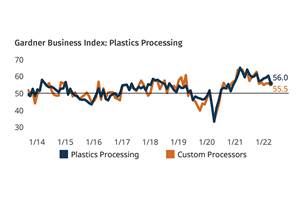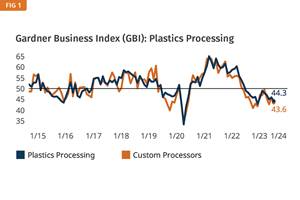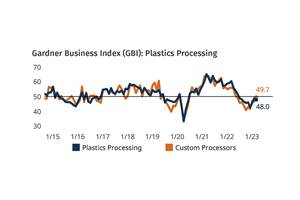Energy-Saving Dryer Pays Off In an Uncertain Economy
Plastics processors struggling through the recession need to save energy costs where they can, they need an affordable means to do so, and they could use energy-saving technology that pays for itself during times when plant throughputs are variable and below optimum capacity utilization.
Plastics processors struggling through the recession need to save energy costs where they can, they need an affordable means to do so, and they could use energy-saving technology that pays for itself during times when plant throughputs are variable and below optimum capacity utilization. The Conair Group believes it has met all three requirements with its new EnergySmart Single-Stage ES-1 dryers that will be on display this month at the NPE show in Chicago.
The ES-1 was developed for processors of PET and other resins that require high drying temperatures, as well as applications where the throughput varies and where electrical costs are high. It takes advantage of technology used in the original two-stage EnergySmart PET dryer, introduced in 2007, and applies it to a less costly single-stage dryer configuration. The new dryer can handle 400 to 5000 lb/hr.
The two-stage system saved energy by recycling a portion of the exhaust air back into the drying hopper about midway up from the bottom. That made productive use of the residual heat and drying capacity in the exhaust air and reduced the amount of dehumidified air introduced at the bottom of the hopper. However, this system adds cost and thus is economical mainly for high-volume PET processing.
CONTROLS ARE THE KEY
The single-stage system is a more economical version, based on a standard Conair Carousel Plus desiccant-wheel dryer without hot-air recycling but with several special technologies added. One of these is the Conair Drying Monitor, a vertical probe in the hopper that has several temperature sensors at different heights. Another is the new TouchView dryer control. A third is a variable-frequency, variable-speed blower in place of the usual fixed-speed blower for process air. And the key to the whole system is Optimizer Mode software in the controller, which uses information gathered by the Drying Monitor. The controls fine-tune the air temperature and flow (thanks to the variable-speed blower drive) and dewpoint to consume just enough heat and mechanical energy to produce the optimum temperature profile. Too much air flow wastes energy, while too little air flow results in poor drying. Similarly with temperature—except that too much heat is not only wasteful but can overdry or degrade the material.
Correct settings can be locked in with a touch of the control screen and can be saved for instant recall. Once set, the Optimizer Mode controls will automatically adjust air flow, temperature, and dewpoint to maintain a stable temperature profile in the hopper regardless of changes in throughput, material temperature, or ambient conditions.
FAST PAYBACK
The ES-1 is said to be especially cost-effective for resins like PET that require precise drying at temperatures as high as 350 F. With PET, the ES-1 reportedly uses 35% to 45% less energy than most other dryers. The Optimizer feature can pay for itself in energy savings alone in as little as six to nine months, according to Jamie Jamison, Conair product manager for dryers. He says the ES-1 can be used with resins that dry at more moderate temperatures, like polycarbonate (250 F) or even ABS (180 F), but the payback period will be somewhat longer. This is indicated by the comparison in the accompanying tables, which also show that energy savings relative to a standard Conair wheel dryer occur primarily when running at less than full load.
There are other advantages besides energy savings, notes Jamison. The Drying Monitor and TouchView control can sense problems such as a clogged filter that reduces air flow to the hopper (which will change the hopper temperature profile), and will sound an alarm. Otherwise, the problem might not be discovered until hours later when defective product is produced. Then the process would have to be shut down while the problem is diagnosed and corrected and fresh material is dried. It could take hours more until production is restarted.
In place of confusing alarm codes and hard-to-navigate menus, the new TouchView control has touch-activated graphics and status indicators that are easy to understand and use. Each control screen displays all parameters and allows each to be individually altered. The unit scans temperatures, dewpoints, and other critical parameters every 15 sec and stores them for 40 hr. When viewed as trending graphs, the data are valuable for QC validation and troubleshooting.
| Table 1—Energy Savings in Drying PET with Optimizer Technology | ||||
Carousel Plus W1600 | EnergySmart Single-Stage | |||
| lb (kg)/hr PET | 1000 (454.132) | 1600 (726.612) | 1000 (454.132) | 1600 (726.612) |
| kwh/kg | 0.1632 | 0.102 | 0.106 | 0.102 |
| hr/yr | 4200 | 4200 | 4200 | 4200 |
| $/kwh | $0.10 | $0.10 | $0.10 | $0.10 |
| Elec. $/yr | $31,128.02 | $31,128.06 | $20,217.96 | $31,128.06 |
| TOTAL | $62,256.08 | $51,346.01 | ||
| Savings/yr with Optimizer | $10,910.07 (17.5%) | |||
| Table 2—Energy Savings in Drying PC with Optimizer Technology | ||||
Carousel Plus W1600 | EnergySmart Single-Stage | |||
| lb (kg)/hr PC | 1000 (454.132) | 1600 (726.612) | 1000 (454.132) | 1600 (726.612) |
| kwh/kg | 0.1024 | 0.064 | 0.069 | 0.064 |
| hr/yr | 4200 | 4200 | 4200 | 4200 |
| $/kwh | $0.10 | $0.10 | $0.10 | $0.10 |
| Elec. $/yr | $19,531.31 | $19,531.33 | $13,160.75 | $19,531.33 |
| TOTAL | $39,062.64 | $32,692.08 | ||
| Savings/yr with Optimizer | $6370.56 (16.3%) | |||
These tables compare the electric cost to dry PET and PC using a traditional Carousel Plus (Model W1600) wheel dryer and new EnergySmart Single-Stage system based on the same dryer equipped with Optimizer technology. Comparisons assume the processor runs 1000 lb/hr half the time and 1600 lb/hr half the time. | ||||
Related Content
Plastics Processing’s Ups and Downs
Overall index dips, but custom processors hold steady. Employment up, backlogs down.
Read MoreNPE2024 and the Economy: What PLASTICS' Pineda Has to Say
PLASTICS Chief Economist Perc Pineda shares his thoughts on the economic conditions that will shape the industry as we head into NPE2024.
Read MorePlastics Processing Business Index Contracts Further
All components dip as index hits low point of 2023.
Read MorePlastics Processing Contracted Again in March
Processing activity contracted for the ninth straight month, and at a faster rate.
Read MoreRead Next
How Polymer Melts in Single-Screw Extruders
Understanding how polymer melts in a single-screw extruder could help you optimize your screw design to eliminate defect-causing solid polymer fragments.
Read MoreProcessor Turns to AI to Help Keep Machines Humming
At captive processor McConkey, a new generation of artificial intelligence models, highlighted by ChatGPT, is helping it wade through the shortage of skilled labor and keep its production lines churning out good parts.
Read MoreAdvanced Recycling: Beyond Pyrolysis
Consumer-product brand owners increasingly see advanced chemical recycling as a necessary complement to mechanical recycling if they are to meet ambitious goals for a circular economy in the next decade. Dozens of technology providers are developing new technologies to overcome the limitations of existing pyrolysis methods and to commercialize various alternative approaches to chemical recycling of plastics.
Read More












